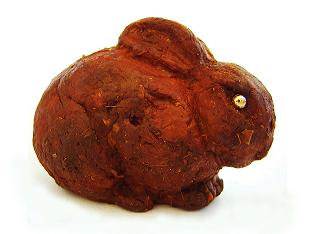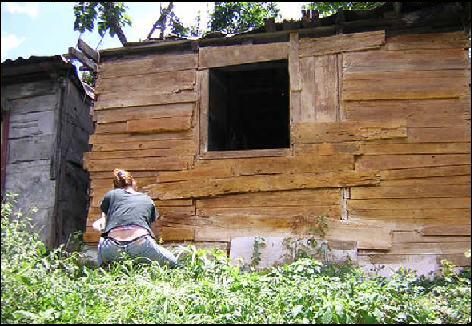Cuban Artist Pioneers Faecal Art
By BARBARA MASEDA
HAVANA TIMES, January 28 – While artists in different periods have used human excrement as a medium of expression, such a peculiar use of the controversial material as that by Cuban artist Grethell Rasua is unprecedented.

Grethell uses the excrements of the people who commission her works of art -not her own as did Italian Piero Manzini in 1961, when he bottled his own feces in 90 metal cans with the inscription “Artist’s Shit”.
Other artists have used human excrement on occasion, at specific moments in their careers, without making it a repeated artist medium. In 2007, Spanish artist Santiago Sierra exhibited in the London Lisson Gallery 21 huge blocks made of excrement gathered in the Indian cities of Delhi and Jaipur, in an effort to raise awareness on the situation of the “untouchables”, an Indian caste that has traditionally cleaned the bathrooms and latrines of the country. But Grethell, who is moved by other aesthetic ideas, has made excrement a recurrent material in her work.
A third significant difference is that Grethell uses the excrement as a building material, making use of its qualities of color, texture, form and its cultural significance. On many occasions she uses it without disguising or isolating it, or hiding it behind other materials, as US sculptor Daniel Edwards did with his famous “Suri’s Bronzed Baby Poop” (2006), a bronze sculpture that supposedly contained the first bowel movement of the baby of Tom Cruise and Katie Holmes.
The examples and the contrasts are endless, so let’s hear from Grethell about the details of her career as an artist that chose what is culturally considered disgusting as a medium to present something beautiful.
HAVANA TIMES: You participated in the Fifth Contemporary Arts Salon at the Visual Arts Center in Old Havana with the work “Valor de la Mirada” (The value of the look). What was that piece about?
GRETHELL RASUA: Valor de la Mirada is a piece I did with Luis Garciga. It’s a piece commissioned for sale made up of the twelve animals of the Chinese Horoscope. Each of these animals constitutes a particular astrological sign for a given person, according to the year they were born. What’s peculiar about it is that to make it, I need a small portion of excrement from the person who commissions the work. The other material I use is gold to make the eyes.
Do those interested have to give you their excrement?
One of the essential aspects of the work is the use of the excrement of the interested party. The people who request this service have to give me their excrement and after a brief period of production the finished order is sold.
How much time is involved, from the time the person gives you the material to when the order is ready?

The production time varies. On the average it takes two to three weeks. The time it takes for the piece to dry completely is influenced by the humidity, both of the air and of the excrement itself. The more dehydrated it is, the faster the drying process.
Could you describe the production process?
Well, after receiving the excrement from the person and the information about their sign on the Chinese Horoscope I begin to process the material. I mix the excrement with oil to be able to work it until I have a homogenous paste. Besides this, I prepare a resin mold that I use to give the piece its initial form. The first time that I remove it from the mold, I proceed to give it a finishing and to add all the details, then I dry it; this is the slowest part of the process of making little animals.
In a first stage of drying I put the pieces in the shade, because otherwise the sun would harden only the exterior without drying the center, which would make the piece crack. So first the piece is allowed to dry in the shade and once it is homogenously dried I put it in the sun so it can continue hardening. As the piece dehydrates it loses the stench, and what’s left is a consistent structure, light and durable.
So then you deliver the piece and the person pays you?
Yes, the sale is also part of the work. The interested party not only participates by delivering their excrement with the idea of it being used as a material to make their order, but also by paying me for giving form to their waste matter and for all the feeling that accompanies that process.
The unavoidable question: Why did you choose excrement?
In this work I use two materials that are absolutely conflicting: gold and excrement. They are opposite materials from all points of view, from their economic value to their cultural significance.
The gold is associated with the desirable, as a sign of value, of wealth, brightness, while the excrement is totally the opposite, symbolizing the despicable, the useless, the stinking waste all that which society rejects.
We seek to transform our universe both materially and abstractly to give a sense to our own history. We make use of the creative act to change the world of shapes and in that way validate their essence. There’s an approval of the senses when what appeared to be unpleasant is transformed; it’s there where the aesthetic opinion of our own tastes changes. The repulsive is converted into something exclusive, special and expensive, with a value both economic and of a reformulated meaning.
In The Value of the Look an unpleasant material such as excrement is chosen, and it is altered to create a pleasant image of a dog, a pig or a horse. This is one way to get people to rethink their impression of the material, to the point where they are willing to pay for the works.
Why the Chinese Horoscope?

The horoscope form comes from my bond with Luis Garciga, the author of the work. We had worked together before and in The Value of the Look we once again cross poetics. He has worked before with the theme of illusion -peoples’ expectations, what’s going to happen tomorrow, the dreams of the future. That’s where the Chinese Horoscope comes in, since it is one of the systems for making predictions.
In this work we seek to give importance to the value of our projections that are being built with our own experience. You can turn to any system for making predictions, be it astrology, esoteric, more or less scientific, but if it doesn’t illuminate your own viewpoint you won’t continue with it.
How has the public reacted to your exhibition? Have you received new orders?
The show has been well received by a public of all ages. The children are very curious and it’s very funny when they suggest changing the name of the gallery at the Visual Arts Center to the “Shit Museum”. A few blocks away from the gallery are the Chocolate Museum and the Decorated Cards Museum, I suppose that they made the association and renamed the gallery.
I also suppose that for the children it may be a little contradictory coming to understand that excrement can be used for something beyond just flushing it down the toilet. Many of us were punished as children for playing with our own excrement; it’s natural that this is one of the first materials humans have contact with, direct experiences with, since it’s inside us.
As far as new orders, we started receiving them from the first day of the opening on November 14. There was one guy that asked me for one that same day. He had gone to the bathroom and brought me a bag with his excrement asking me to make him a tiger, which is his sign. To date we’ve received a dozen orders.
Had you used excrement in past shows?
Yes, several times. In 2005 I undertook a beautification project of a house in a poor neighborhood on the west side of Havana called “El hueco”, (the hole) in the municipality of La Lisa. The work was titled “Dual” and consisted of giving color to the exterior of a house with the only material that the residents had in abundance: their own excrement. I made a varnish that consisted of 70 percent excrement from these people mixed with 30 percent clear varnish and it was applied to the house.

Little by little the residents of the home gave me their excrement; I made the varnish and then painted. When I first made the proposal, several people were opposed to the idea. Finally one family agreed and when it was finished the rest of the neighbors had changed their minds.
In another action titled “With you own flavor” (2005-2006) I proposed to some 20 people the possibility of obtaining at a modest price fresh plants of condiments and dried spices, grown with human excrement as the fertilizer. In all there were 15 spices and 13 fresh condiments that the subjects selected to give flavor to their meals. In that way they blended the beginning and final stages of the food chain.
When in your career did you begin to work with this material?
From the time that I graduated from the San Alejandro National Fine Arts Academy in 2004 I have worked with human body wastes, things usually excluded from any strong aesthetic reference. My graduation thesis, for example, was a work titled Con todo el gusto del mundo (With all the taste of the world), which was also a paid commissioned work that I’ve continued doing to date. It’s a service offered to interested persons to use their own body wastes however they like. The only thing they must do is order the desired object, a specific design and the waste chosen to make it. They are pieces that contain a popular aesthetic. After the elaboration process we have unique completely functional pieces that can be purchased at a good price. These articles circulate in the space created for them, mainly for the owners to carry them or use them in their homes.
Could you give us some examples of the orders you received at that show?

People made all types of requests. Plates embossed with vomit, glasses with a double lining containing urine, a pair of woman’s underwear embroidered with menstrual blood. Many ornaments as well: rings with semen, hair clasps with dandruff, earrings containing blood. I made some engagement rings with gold, resin and blood. A mother that had just given birth ordered earrings containing breast milk. On the items to be worn I always use transparent resin to isolate the organic material and thus the people can use them on a daily basis with deterioration. On other occasions I use it without sealing it in resin, depending on the characteristics of the material, depending on the order.
Any last words on what it means to you as an artist and a person to have selected your path in the world of plastic arts?
It’s fascinating work. And it’s a very valuable learning tool for a professional, because it forces you to be disciplined, responsible and it gradually enriches you as a person in all senses. I’ve taken it on as an activity that centers my life. I’ve taken art as a space for research, reflection and a theory of reality.
Also, the interaction with people is very worthwhile. It’s interesting to see the way people assimilate the work, many times straying away from the original objectives, according to the symbolic universes of each individual. On many occasions the pieces motivated people to understand their own reality from another viewpoint, from that of art.

Comments are closed.